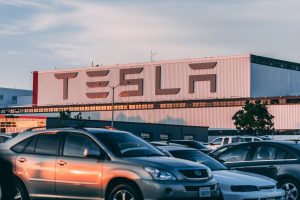Florida Car Accident Lawsuit Alleges Tesla’s Futuristic Doors Made the Vehicle a “Death Trap”
 The crash itself, into a palm tree after the driver lost control, should not have killed him. He had not even suffered any broken bones. But according to the South Florida car incident lawsuit, an alleged malfunction of the Model S Tesla’s doors meant there was no escaping the electric vehicle after the lithium battery ignited. First responders, finding no other way to extricate him, watched on helplessly. The anesthesiologist’s widow says he died from smoke inhalation. Now, she’s suing Tesla, on behalf of herself and their five children.
The crash itself, into a palm tree after the driver lost control, should not have killed him. He had not even suffered any broken bones. But according to the South Florida car incident lawsuit, an alleged malfunction of the Model S Tesla’s doors meant there was no escaping the electric vehicle after the lithium battery ignited. First responders, finding no other way to extricate him, watched on helplessly. The anesthesiologist’s widow says he died from smoke inhalation. Now, she’s suing Tesla, on behalf of herself and their five children.
The retractable door handles are supposed to auto-present when a key fob is detected nearby, the lawsuit said. But this time, it did not. The door handles could not be accessed, rendering the car a “death trap.”
This is far from the first time a Tesla has caught fire. Our Fort Myers car accident attorneys anticipate that unfortunately, this will probably be far from the last wrongful death lawsuit with a similar fact pattern.
Just last year, two teenagers died after the Tesla they were occupying crashed into a wall and burst into flames. A third passenger survived but was seriously injured after being ejected.
Fire Risk in Tesla Electric Vehicles
A report by Business Insider earlier this year cited data from the National Fire Product Association noting that about 325 people die annually on average in internal combustion engine vehicle fires. That is a lot (325 too many), but it is also spread out over 264 million registered vehicles in the U.S. That breaks down to about 1.23 vehicle fire deaths per 1 million vehicles (nearly 60 percent of those happening when the vehicle rolls over). Tesla has not yet produced 1 million of its electric vehicles yet; closer to little more than half that. If Tesla were any other vehicle, the rate of fire deaths should statistically be fewer than 2 people. But journalists have counted at least 20 widely-reported incidents of the vehicles catching fire in the last six years and six people have died just in the last year in these cases – half of them in Florida.
Tesla countered that in most cases, the vehicle occupants were speeding, operating the vehicles outside the agency testing parameters and most likely died from impact-related injuries, not the subsequent fire.
First responders, though, note some of the cars have ignited even when there has not been an impact, and firefighters must use special care in putting out these fires. Foam or dry chemicals will not work to put out a lithium-ion battery fire. Instead, it requires hundreds or thousands of gallons of water, manpower, and patience. Furthermore, the fires can reignite even after they seem to be under control.
Tesla Manufacturing Defects
Numerous online tutorials and blogs discuss “How to open a Tesla door,” suggesting the danger with the malfunctioning auto-present feature is no all that unique, even if there are as yet no other widely-published reports of anyone else being trapped in an emergency.
However, our Fort Myers car accident lawyers are aware of a number of high-profile manufacturing mishaps at Tesla. This may not be more than any other vehicle manufacturer, but the incidents are concerning nonetheless. For example, there was one incident where mechanical oil got into one of the machines used to press the chemicals of the vehicle battery into a single sheet – effectively contaminating all products it touched. Production came to an abrupt halt and millions of completed battery cells had to be sorted through to identify any that might have been impacted.
There have also been incidents of various tools and scissors falling into chemical and lithium mixtures – a mistake that could result in shrapnel in the battery that could easily result in a hard short or a fire.
It is not yet clear if either of these incidents could be linked to any of the fatal fires.
Typically product liability claims involving motor vehicles come in one of two forms:
- Defective manufacturing. This occurs when there is some error at the facility where the part/vehicle was made (like tools falling into lithium battery mixes) or some kind of problem that occurs during shipping.
- Unreasonably dangerous design. In this case, the vehicle was manufactured properly, but the design of it was unreasonably dangerous (such as door handles that aren’t accessible in an emergency).
Even if defective vehicle manufacturing or dangerous design is not the cause of the crash, if it exacerbates the extent of injuries or damages, auto manufacturers can be held liable.
If you are injured in Fort Myers or the greater South Florida area, contact our injury attorneys at The Garvin Firm at 800.977.7017 for a free initial consultation.
Additional Resources:
Lawsuit blames Tesla motorized door handles for death of driver stuck in burning car, Oct. 24, 2019, By Zac Palmer, AutoBlog.com
More Blog Entries:
Florida’s Choice of Law Doctrine in Car Accident Lawsuits, Oct. 17, 2019, Florida Car Accident Lawsuit Blog





 Florida Personal Injury Lawyer Blog
Florida Personal Injury Lawyer Blog










